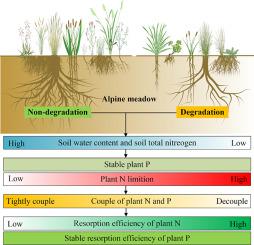Ecological Engineering ( IF 3.9 ) Pub Date : 2021-06-18 , DOI: 10.1016/j.ecoleng.2021.106323 Tiancai Zhou , Ning Zong , Jian Sun , Ge Hou , Peili Shi

|
Exploring the early warning signals of plant and soil characteristics in response to degradation is of great theoretical significance to illuminate the underlying driving mechanism of alpine meadow degradation. Here, in alpine meadow of Damxung County on the Tibetan Plateau, a field survey along degradation gradients was conducted to measure plant and soil properties: from non-degradation to severely degradation, simultaneous impairments in plant total biomass, plant coverage, plant N concentration, soil moisture, soil total C and N were detected, which significantly (P<0.05) decreased by 85.36%, 54.30%, 25.23%, 26.95%, 28.94% and 12.85% in sequence, while no significant change in plant P concentration was observed. As grassland degradation increased, a consistent decrease of plant N: P ratios (<14) not only demonstrated that N was a strong limiting factor for plants growth, but also supported our hypothesis that plant N concentration was more sensitive in response to degradation than plant P concentration. Path analyses further indicated that soil moisture and soil total nitrogen were the most critical factors that mediated the plant N: P in response to degradation. Although our findings suggested that N resorption efficiency was improved after grassland degradation, the increase in grassland degradation would enhance the N concentration decoupling from P concentration, which in turn might further exacerbate the N limitation and the degradation in alpine ecosystems. The early-warning signals of grassland degradation obtained here not only can improve the understanding of grassland degradation, but also can provide guidance for the restoration and management of degraded alpine meadow on the Tibetan Plateau.
中文翻译:

植物氮浓度对退化的反应比高寒草甸中的磷浓度更敏感
探索植物和土壤特征响应退化的预警信号,对于阐明高寒草甸退化的潜在驱动机制具有重要的理论意义。在这里,在青藏高原当雄县高寒草甸沿退化梯度进行实地调查,以测量植物和土壤性质:从未退化到严重退化,植物总生物量、植物覆盖度、植物氮浓度同时受损,土壤水分、土壤全碳、全氮含量显着(P<0.05) 依次降低 85.36%、54.30%、25.23%、26.95%、28.94% 和 12.85%,而植物磷浓度无明显变化。随着草地退化的加剧,植物 N:P 比率 (<14) 的持续下降不仅表明 N 是植物生长的强大限制因素,而且支持我们的假设,即植物 N 浓度对退化的反应比植物更敏感。磷浓度。路径分析进一步表明,土壤水分和土壤总氮是介导植物 N:P 响应退化的最关键因素。虽然我们的研究结果表明,草地退化后 N 吸收效率有所提高,但草地退化的增加会增强 N 浓度与 P 浓度的脱钩,这反过来可能会进一步加剧高山生态系统的氮限制和退化。在这里获得的草地退化预警信号不仅可以提高对草地退化的认识,而且可以为青藏高原退化高寒草甸的恢复和管理提供指导。











































 京公网安备 11010802027423号
京公网安备 11010802027423号